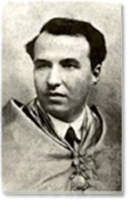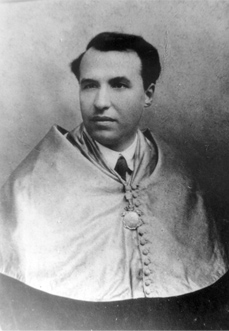 Born in Alicante on 29 June 1883, the son of a shopkeeper, Germán Bernácer had a very productive career as an economist working in Spain. He completed his studies at the Alicante School of Commerce in 1901, where he was awarded the chair of industrial physics in 1905; in many ways his background in physics provides the best clues for his approach to economics, particularly in relation to methodology, but more especially his insistence on the study of economic dynamics and disequilibria, rather than upon general equilibrium and static analysis. He became the first director of the Research Service of the Bank of Spain (1930–55), but there is a general view that his prominence in this role was curtailed because of his political views and also perhaps because of his disagreements about exchange rate policy with leading Spanish economist Flores de Lemus, who commanded more popular support.
Born in Alicante on 29 June 1883, the son of a shopkeeper, Germán Bernácer had a very productive career as an economist working in Spain. He completed his studies at the Alicante School of Commerce in 1901, where he was awarded the chair of industrial physics in 1905; in many ways his background in physics provides the best clues for his approach to economics, particularly in relation to methodology, but more especially his insistence on the study of economic dynamics and disequilibria, rather than upon general equilibrium and static analysis. He became the first director of the Research Service of the Bank of Spain (1930–55), but there is a general view that his prominence in this role was curtailed because of his political views and also perhaps because of his disagreements about exchange rate policy with leading Spanish economist Flores de Lemus, who commanded more popular support.
There is no doubt that his most important and most influential writings were between 1916 and 1926 in the early years of his academic career; his later writings were less penetrating and represented new interpretations and new perspectives on his earlier theories, particularly in the light of the Keynesian revolution. Indeed, by the 1940s, like Dennis Robertson, whom he greatly admired, he was spending too much energy in criticizing Keynesian economics and also in illuminating the anticipatory nature of his own earlier work, rather than refining and developing his own considerable contribution.
It is surprising to find that Bernácer is not much better known to English-speaking economists, for he distributed his publications widely among leading economists in Europe and the United States. For example, he troubled himself to send 150 copies of a 1923 offprint (published as a pamphlet) of his 1922 Spanish article, “La teoría de las disponibilidades,” together with a French summary, to prominent economists and journals around the world—including not only Keynes, but also Robertson and Ralph Hawtrey. His correspondence shows a variety of exchanges with many of them, particularly from 1940 to his death in 1965 (although most simply acknowledged receipt of the 1922 article at that time). His talents in economics were, to some extent, matched by his linguistic abilities, as he was quite ready to communicate in other main European languages as well as in Spanish. However, as far as writing papers was concerned, he felt much more comfortable with German (14 articles between 1941 and 1956) and Italian (10 articles between 1948 and 1964) than with English (just 1 article, in Kyklos, in 1950), apart from 34 articles published in Spanish between 1918 and 1962. He made full use of his linguistic abilities with extensive correspondence not only with Robertson, but also with Jacques Rueff, Erich Schneider, Henry Wallich, Gott fried Haberler, and Howard Ellis, among others.
Despite these attempts to have his work read by the leading economists, he remained a very modest, indeed shy, person:
I would like to stress the great humility and modesty that characterized his person; whether his theories were imitated or copied did not in the least bother him, his main preoccupation being that they were not deformed or adulterated. Personal prominence never interested him, although always maintaining a fervent desire to make known by the means within his reach, the results of his investigations. In addition to his early vocation for the Natural Sciences, he felt the need to dedicate himself intensely, as a theme of highest priority, to the Economic Sciences, which he found to be an empirical discipline lacking scientific approach. He longly reflected on the mechanisms that govern them, penetrated their secrets and took on the task of divulging them, endeavoring to attain a better fate for his fellow beings, whose future he augured very somberly, foreseeing great crises, wars and tyrannies. I well recall a phase he bitterly repeated: “. . . they copied it, but they copied it badly . . . ,” referring to his work of 1922 which he diffused amongst the specialists of highest renown at the time.
Letter from his son, Germán Bernácer, to John Presley, dated 7 March 2001.
The turning point in being more widely read by English-speaking economists came in 1940 when Dennis Robertson took it upon himself to have long extracts from Bernácerʼs 1922 article translated from Spanish to English and, with his own commentary, had it published in Economicaunder the title “A Spanish Contribution to the Theory of Fluctuations” (Robertson 1940b). Robertson had attempted without success to establish contact with Bernácer previously to the publication of the article. However, soon after the publication of Robertsonʼs article, the journal editor Lionel Robbins managed to discover Bernácerʼs whereabouts and sent him a copy of the issue of Economica. Bernácer started to correspond with Robertson after that, and he remained eternally grateful to and exceedingly respectful of him.
Bernácerʼs hard luck, of course, was that the Second World War diminished the attention paid to purely theoretical discussions, including the 1940 article. However, the war did not prevent Haberler from referring, in the Spanish edition of his classic book, to Bernácerʼs “important and original” contribution to business cycle theory on the basis of Robertson ʼs article. On 26 April 1945 Haberler invited Bernácer to write an article on business cycles for the Review of Economic Statistics.
Bernácer promptly sent Haberler a manuscript summing up his ideas on the topic, but he would disagree with Haberlerʼs request to make several changes in the paper. As pointed out by Haberler in a letter of 30 October 1945, “It was only with the greatest hesitation that we ventured to ask you to rewrite your article so as to make it more understandable for the American public. I realize that that is quite an imposition and cannot blame you for not being willing to undertake such a revision.” Haberler then suggested that, “in order to put your ideas before the Anglo-Saxon public we could arrange for a review of your book by a competent economist who knows Spanish.” The book mentioned by Haberler in his letter was La doctrina funcional del dinero (The Functional Theory of Money) (Bernácer 1945), in many ways a summary of Bernácerʼs own work to date with comparisons drawn to contemporary work. As pointed out by Bernácer in a letter of 4 July 1947 to Robertson, that book was “entirely born under the impulsion of [Robertsonʼs 1940b] article.” Henry Wallich (1947) wrote a comprehensive and perceptive review of La doctrina for theReview of Economic Statistics, in which he referred to Robertsonʼs Economica article and to Bernácerʼs longtime struggle to be acknowledged by En glish readers.
Some of the more critical points raised by Wallich in his review would be taken up in the ensuing correspondence with Bernácer, as described below. In 1945 Bernácer also corresponded with Fritz Machlup, then editor of the American Economic Review. Machlup thanked Bernácer in a letter of 24 September 1945 for reprints of his works, and wrote that “I had been familiar with your most interesting contributions to the theories of money, capital and cycles.” It was probably thanks to Machlup that the American Economic Review would publish a review of La doctrina, written by the Hispanic- American economist Virgil Salera, in 1947. Although not as thorough as Wallichʼs review, Salera provided a useful and flattering overview of the book. Salera (1947, 221) regarded Bernácer as “one of the most capable continental technicians” in the fi eld of monetary theory, but emphasized that the second half of the book concerns itself entirely with monetary controversy, with a critical appraisal of Keynesʼs work, alongside a less detailed and more sympathetic treatment of both Hawtrey and Robertson. In conclusion the review is favorable, suggesting that “students of monetary economics will do well to consult the volume, since virtually the whole of the Keynesian apparatus is subjected to searching—and sometimes highly suggestive—criticism”. Bernácer also attempted to have his 1945 book reviewed in Economica, but regretted in a letter of 4 July 1947 to Robertson that the journal (then edited by F. A. Hayek) could not find a British economist with sufficient knowledge of Spanish and monetary theory to do the job. That was Bernácerʼs second disappointment with Economica since the breakthrough of Robertson 1940b. He had been disappointed in 1942 by Robbinsʼs decision not to publish an English translation of his 1941 Spanish article “La teoria monetária y la equacion del mercado,” where, among other things, he answered to Robertson ʼs critical remarks about some aspects of his 1922 piece of dynamic analysis.
After this burst of publicity, little was then heard of Bernácer in U.S. journals until 1957, when again the American Economic Review published a review of one of his works, this time his Una economía libre, sin crisis, y sin paro (A Free Economy without Crisis and Unemployment) (1955). The review was by the Cuban economist Jorge Freyre. In Una economía libre Bernácer, differently from his 1945 volume, discussed extensively his interpretation of the determination of the rate of interest and its implications for economic policy. At last Bernácer received the kind of acclaim and acceptance that he had been looking for; the book is very much a restatement yet again of earlier books in that it “constitutes an uncompromisingly liberal effort to develop an institutional framework for a free economy. In Bernácerʼs system, unemployment, depression, and inflation find their cure with a minimum of direct government action. By the same token, the system restores and protects economic liberty, which the author sees threatened by growing interventionism” (Freyre 1957, 436). The verdict is that “the book is brilliantly written.” “Bernácerʼs views resemble those of many neoliberals today. He differs substantially, however, in his pessimism regarding the effectiveness of the interest rate as a device for achieving equilibrium, and in the greater radicalism of his reform proposals. Fundamentally, Bernácer seems to take a Rousseauesque approach to economics; the market system is good, but some of the institutions which man has created are bad”.
Despite all of this, Bernácer remained neglected. Together with his 1950 article titled “Money and Freedom” in Kyklos, the 1940b article by Robertson was the only piece written by Bernácer which was ever published in English, where English readers could get direct access to Bernácer ʼs views. However, “Money and Freedom” was mainly a restatement and clarification of the views he had put forward in 1922 and that Robertson (1940b) had brought to light. The Kyklos article resulted apparently from Bernacerʼs failure to have a previous version published in the Review of Economic Statistics. In letters of 21 and 26 February 1946 Robertson acknowledged an English paper by Bernácer, which Robertson partly rewrote. Bernácer thanked Robertson on 4 April 1946 for “rewriting in your excellent English the essentials of my paper on the theory of money.” “Money and Freedom” was submitted to Kyklos in November 1947. A revised version—with corrections to some of the English and with changes in the argument, both made on the basis of suggestions by W. Stolper, who acted as a referee—was accepted by the editor, H. G. Bieri (letters of 30 November 1947, 23 March 1948, and 29 December 1949 from H. G. Bieri to Bernácer). Bernácer probably sent his manuscript to Kyklos because, after his failed attempts to publish articles in the United States and in the United Kingdom, that new journal (started in 1947) was the only one on the Continent in which he could publish in English. Bernácer took considerable time and effort to assist some of his correspondents by having their work translated into Spanish and published; other than the apparent benevolence of Robertson, which is considered later, no one ever took the trouble of cajoling a U.S. or U.K. publisher to accept one of Bernácerʼs books or papers for translation, even though Bernácer remained persistent through to his death in 1965 in seeking support from major economists to have this done.


